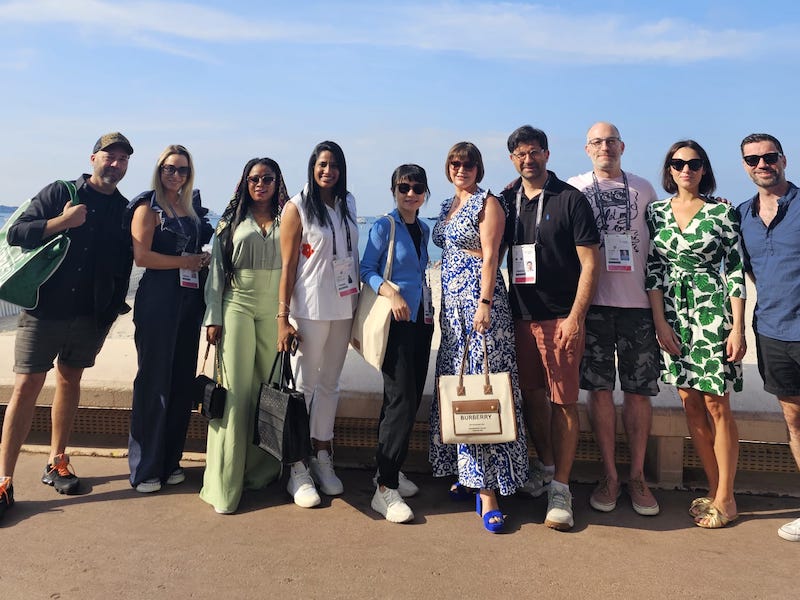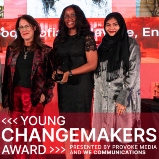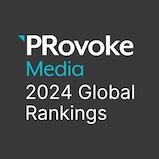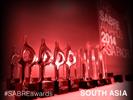Maja Pawinska Sims 23 Jun 2023 // 4:17PM GMT

CANNES — Members of the PR Lions jury outlined the framework they used to choose the winning work at Cannes Lions International Festival of Creativity, and shared their insights from and experience of the judging process at PRovoke Media’s annual roundtable in Cannes this week.
Jury president Jo-ann Robertson, Ketchum’s global markets CEO, said she asked the 10-strong awarding jury to apply a simple but rigorous formula to assess the shortlisted campaigns in the PR category: “is it earned at the core, does this live deep in culture and did it actually have any impact?”
Robertson told PRovoke Media: “I was on the jury last year and came in as president with a vision of how to set jurors up for success. This framework allowed us to hold ourselves accountable, and we were really disciplined. A lot of work fell down on impact, whether commercial or societal: anything that could show us that the campaign had actually achieved something.”
Of his experience of the judging process, FleishmanHillard head of creative strategy Brian Melarkey said: “What struck me most was that we arrived with our own opinions but very quickly got the measure of each other and respected each other’s opinion. We were a room full of strong personalities but we listened, discussed and persuaded, and the framework made it easy to rate the work. There were campaigns I initially thought would get gold that didn’t end up featuring – you start off being passionate about something and then you let it go, so there were surprises.”
Robertson said: “Everybody gave it 100% from the moment we arrived. There was a lot of debate but no arguments. The responsibility of being president weighs heavy – as an industry we are quite navel-gazing about Cannes, but a lot of it is a numbers game – we had 1,600 entries and the vast majority were from ad agencies. PR doesn’t have a god-given right to win in the earned category, especially with the convergence of disciplines. We have to work harder to lead in earned – and a lot of incredible work from PR agencies is just not coming to Cannes.”
She urged the PR industry to approach Cannes Lions entries as more than contributing partners in integrated campaigns: “I’m super-proud that Edelman and Ketchum were awarded metal as creative idea leads, and the whole PR industry should be proud of that. Lots of PR agencies were listed as contributors – but they should be entering their own work.”
Robertson added: “At a macro level our understanding of what is earned needs to evolve – it’s not just media coverage – for us as a jury and an industry, earned media is where we create a moment, a story or content that people organically share and talk about. It can live on social or the real world, but if you’re having to spend millions of dollars to put an idea into people’s faces, that’s not earned. You have to ask yourself: why should anyone care about this? The best earned work can’t be ignored. It’s new, difficult, funny.
“As an industry we are leading in earned, but our advertising and media brothers and sisters recognise that, and we need to keep pushing, because that’s where the magic is.”
The jury said the balance of purpose and commercial work featured strongly in their discussions, and they also stressed the importance of levity and fun in the stand-out work, as well as other emotional responses.
Melarkey said: “Purpose is always at the fore in Cannes. This year, while purposeful work was strong, we were rigorous in how we assessed it. Purpose isn’t enough: impact and legacy – whether it lives beyond the moment – was important for us. I was so happy to see so much fun, brave commercial work that does its job of connecting with the audience.
“Emotion doesn’t always have to be sad – it can be humour and joy, and I think we awarded a lot more of that. I’m looking forward to brands being a bit braver about being commercial and fun. We need heavy-hitting emotional work and also work that makes us smile – and our Grand Prix did that.”
There were a number of strong trends in the winning work, said the jurors. Edelman’s global creative director Andrew Simon said he was struck by the simplicity of many of the best campaign ideas: “It was about boiling it down to the core of the issue and doing an amazing job of staying true to that idea and amplifying from there. The winning work can explain the idea in a sentence and then talk about impact and amplifications.
“Simple ideas are powerful ideas. They also embrace technology, but not for its own sake: technology is best used to help us become more human.”
Golin Hong Kong MD Carol Yeung, who was on the shortlisting jury, also said clever use of technology had stood out for her: “It’s about using technology in a meaningful way – for instance using gaming to educate people about a cause. There was also a focus on unsung heroes – the work wasn’t all about celebrities and brand ambassadors, but about the people behind the brand.”
Simon also noted the return of more more lighthearted campaigns to the shortlist: “Humour is the most underestimated emotion when it comes to Cannes – it has an incredible impact on the way people feel and think. We think that PR equals purpose and purpose equals awards, but that’s not true, it’s about how we get people to feel. The best work to me was humorous, because humour is deadly effective.”
Melarkey agreed that humour was a distinct trend this year: “Don’t underestimate how difficult it is to make everyone smile. You could see the moment in the Grand Prix case film where everyone realised what had happened, where all the pieces aligned.”
He also noted that this was probably the “pre-AI year”, with only one campaign featuring AI on the shortlist: “Next year this will multiply by 1,000, but it’s about how we employ AI to make what we do better.”
For Pinto, the assessment process was about seeing the work through the lens of “megatrends” such as climate, technology and gender: “The cases we chose talk to some of those megatrends and a progressive way of looking at issues – for instance, the subtleties of women’s wellbeing and equality came through in the Grand Prix – they didn’t have to call it out and tell everyone to pay attention, it’s about the subtle ways you can bring creativity to megatrends and get people to take positive, purposeful action.”
Hill+Knowlton Strategies global head of content and publishing Vikki Chowney made no apology for focusing on the content elements of the shortlisted campaigns: “It’s not just about the presence of beautiful content and the beautiful presentation of data, but how it is integrated, framed and designed – I was super-happy to see a lot of entries use content in a way specifically designed to make you feel something or talk about something.”
The jurors also shared their key learnings from being on the PR Lions jury – and their reflections on where the PR industry stands now in the creative ecosystem, after another year of most winning campaigns in the category being won by ad agencies.
Simon had one message for PR agencies in their approach to their work, and to Cannes Lions entries: “Be bold, and be brave. When you look at a lot of ad agency work, you do think ‘was any risk management involved in this?’ But we do have to take bigger swings, we need to keep bringing the discipline and the smarts, but also take more chances. Don’t be bitter, be better.
“PR is in a great place – everyone can elevate their game but it needs willingness and an understanding of what it takes. We’ve invested heavily as an industry in creative and strategy and we need to be willing to bring in new people and different ways of looking at things. After this, I will be tougher on everything we do, and challenge our teams to not stop too early with the potential scale of the work if they want to do something meaningful, with real impact and legacy.”
Melarkey was similarly confident about the PR’s position in the creative universe after this judging experience, with some caveats: “I do believe there is something in our formula that doesn’t exist anywhere else, and if we don’t seize that other disciplines will. We need to believe in ourselves.
“I will take back two things: we can sometimes be ‘yes men’ to our clients – like when they say ‘our audience is everyone’ – but we need to be more disciplined and say we can’t be everything to everyone. The Grand Prix campaign understood its audience really well, and had a crystal-clear idea because they understood exactly who they were talking to.”
“Secondly, while there’s no lack of egos in PR, we need to be really proud of our ideas and know how to sell them better. Stop, step back, work out what the work is you want to put out in the world, and encourage everyone on your team to shoot for Cannes.”
Yeung said her key takeaway was looking at “how we can think bigger than the brand and use data more creatively”, while Chowney said she had learned about how to put together a winning entry: “I’m excited to take the work back to the team and dig into it. And as PR agencies we also need to spend more time on the process of entry – people are entering things into the wrong category, and that means so much great work is missed out.
“We need to take more time to tell our stories – ad agencies show up so well because they spend time working out the narrative and presenting it in a clear, dynamic way. It’s tactical, but important.”
Pinto said she would leave Cannes feeling even more confident about PR: “We’re sitting in a very sweet spot, and we have the power to do a lot more, better creative work, steeped in context, content, and culture which sparks conversations. It’s very positive for how we are looking at creativity in PR – we just need to push ourselves a few notches higher, with clarity, simplicity, focus and big comms ideas.”
Reflecting on what she would take away from the judging process Robertson said she thought the PR industry was only getting started: “Our potential to grow and lead in the creative space is undeniable, but as an industry we need to be more collaborative – of course we’re commercially competitive, but across trade associations and trade media we need to talk PR up, not down, celebrate the best work wherever it’s come from, and help each other to get to real impact.
“In the grand scheme of things, PR is still relatively small, and working together in a supportive and inclusive environment is an untapped opportunity.”
Robertson said the experience of working with her fellow jurors had also underlined the need for PR to become more diverse: “We have so many brilliantly smart and creative people in our industry and I had the pleasure of spending the week with nine of them – if want to continue to attract the very best people, we have to make our industry more inclusive, more diverse, better paid, more meaningful in terms of what people get out of being part of this amazing industry, and we need to work together to really attract the next generation of brilliant minds.”



































.jpg)

















